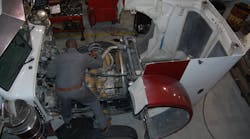As today’s engine operating temperatures have gotten higher and higher, more pressure has been put on the cooling system. When the cooling system fails to do its job, engine life suffers.
Fleets today have a choice in types of coolants from conventional and fully formulated to extended life. While each coolant type is designed to protect the engine, each has its pluses and minuses. There is no one answer about which coolant is best for your operation.
Before deciding which coolant is right for you, it’s important to understand the different types currently available. The first is conventional coolant that needs a pre-charge of Supplemental Coolant Additives, the additives designed to protect cylinder liners from corrosion. Conventional coolants also require SCA to be added at periodic intervals.
Fully formulated coolants can use ethylene glycol or propylene glycol as their base, but there is no need to pre-charge these coolants at initial fill as the SCA package is already in the product. However they may need periodic additions of SCA at 25,000-mile intervals or as recommended by the engine maker.
Extended life coolants do not require the addition of SCA for 300,000 (for coolants using Nitrited Organic Acid Technology) or 600,000 miles (for those using Organic Acid Technology).
To help fleets identify different types of coolant and clear up confusion, The Technology & Maintenance Council established a recommended practice (RP 351) for coolant colors.
Green: Conventional coolants
Blue: Fully formulated propylene glycol based coolants
Purple/Pink: Fully formulated ethylene glycol based coolants
Red: Extended life coolants
Why the need to standardize on coolant colors? One of the main reasons is that it’s generally not recommended to mix different types of coolant together. When you do, you dilute the inhibitor package and lessen its effectiveness at protecting the engine. Some coolants can become contaminated when mixed with other types of coolants.
Regardless of type all coolants need periodic maintenance. Things like color, clarity, odor, freeze point and chemical protection levels need to be investigated. Start by checking the color of the coolant to make sure it matches with what you think is in the cooling system. TMC’s RP recommends a label at the filler point indicating which color coolant is in the tank.
Once you’ve confirmed the type of coolant in the truck, check for clarity. Coolant starts out clear and should remain clear if it is working properly. If the coolant has a milky appearance, it’s a sign of an oil leak. Coolant that is black or brown and has an unusual odor indicates a problem in the cooling system.
Check freeze protection to make sure it is at its optimum level, -34°F. TMC recommends using a refractometer for the check. Coolant test strips can be used to check inhibitor levels to make sure they are not too high or too low.
If you discover that the coolant has degraded drain the cooling system, flush it with a cleaner and then refill it with the proper coolant.
Industry statistics point to coolant as the cause of 40% of all engine problems. Selecting the right coolant for your application and maintaining the cooling system on a regular basis is a simple way to keep your truck’s engine running properly.



